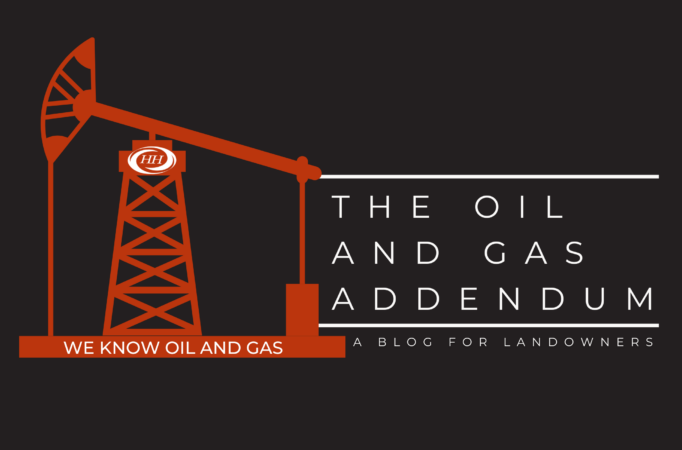The Oil and Gas Addendum
Not Your Father’s Oil and Gas Lease
Horizontal Drilling Presents Unique Leasing Issues
The modern oil and gas lease is a sophisticated and complex legal instrument that has evolved over the last several decades. This evolution, however, has generally occurred within the “vertical well” context. Recent technological advances in horizontal drilling and hydraulic fracturing have resulted in unprecedented leasing activity throughout Pennsylvania. The advent of horizontal drilling has introduced new and unique concepts that the traditional vertical lease was simply not drafted to address. As a result, many landowners and gas operators throughout Pennsylvania have grown frustrated and disillusioned with their “vertical leases” that inadvertently hinder and delay horizontal drilling and hydrocarbon development. This unfortunate and troubling result could have been avoided had the parties simply tailored their leases to reflect the needs and challenges of horizontal drilling.
The concept of “pooling” is vitally important in the era of horizontal drilling. Because geologic formations such as the Marcellus Shale do not follow or parallel surface boundaries, gas operators must often combine or “pool” separate leased parcels together in order to form a larger production unit. Unlike traditional shallow gas formations, the Marcellus Shale formation is known as a “tight” formation: the natural gas is trapped within nonporous and impermeable rock seams and does not migrate naturally. The lack of permeability in this target formation is resolved through the use of long lateral wellbores and hydraulic fracturing. These long lateral wellbores, however, can exceed 5,000 feet and inevitably cross surface boundaries. Each tract in which the horizontal wellbore is drilled through is considered a “drill site” and must be under lease.
In order to design and drill such lateral wellbores, the gas operator must first have the contractual right to “pool” the various leased parcels into a single production unit. In Pennsylvania, there is no compulsory pooling that can be ordered or imposed by state agencies. As such, pooling is purely a matter of the parties’ contract and must be specifically included in the lease. The pooling clause in the underlying lease therefore creates several negotiation opportunities that are unique to horizontal drilling. Typically, these issues involve the proper allocation of production royalties, horizontal “Pugh” clauses and anti-dilution clauses.
I. Pooling and Royalty Allocation
Of critical importance to every landowner is the production royalty negotiated with the gas operator. Many landowners, however, fail to appreciate or realize the impact pooling will have on their royalty calculations. The principal effect of pooling is that operations or production occurring on one tract located within the pooled unit will be regarded as having occurred on each and every tract in the unit. In other words, if there are 30 separate parcels in the unit, a well pad site drilled on one parcel will “hold” the leases of the other 29 parcels. Moreover, the 18% royalty negotiated by those 29 landowners in their respective leases may not be as lucrative as initially thought. Instead of receiving a straight 18% production royalty on all production from the well, the landowner receives an 18% royalty based on his pro rata share of acreage in the overall unit. For landowners with 50 acres in a production unit consisting of 1,280 acres, it is easy to see how the production royalty from a horizontal well can be significantly diluted.
One of the mechanisms used to minimize this dilution effect is the Anti-Dilution Clause. This clause requires the gas operator to include either the entire tract or a certain percentage of the landowner’s acreage in any production unit. A typical clause may read as follows:
“[I]f any pooled unit is created hereunder, at least 75% of the pooled unit shall consist of the Leased Premises.”
For landowners with larger holdings (i.e., in excess of 500 acres), the Anti-Dilution Clause can mitigate the dilution brought about by pooling. Typically, horizontal drilling requires units between 640 and 1,200 acres. As such, a landowner with less than 500 acres likely will not have much success in negotiating an effective Anti-Dilution Clause. Such landowners must explore other royalty clauses unique to horizontal drilling in order to minimize dilution and increase royalty integrity.
There are two alternative methods for allocating production from a horizontal well among the various tracts in a pooled unit. One method is based on the “relative bore length” and another is based on the number of “take points” located within the geological footprint of the leased premises. When used in conjunction with the traditional surface acreage allocation, these methods can reduce royalty inequities.
The “relative bore length” method allocates the production royalty based on the length of the horizontal wellbore within a particular parcel in relationship to the total horizontal length (i.e., the length between the penetration point and the terminus). In other words, the royalty is based on how many linear feet of the wellbore actually passes underneath the leased parcel. Similarly, the “take point” method allocates the production royalty based on how many wellbore take points or open perforations are located within a particular tract in relationship to the total number of take points along the entire producing lateral wellbore. These methods place greater emphasis on the actual location of the lateral wellbore as opposed to the acreage of the surface premises. Reliance on surface acreage alone can produce inequitable royalty allocations.
For example, assume a production unit of 700 acres. Tract A consists of 100 acres. Tract B consists of 25 acres. Using the surface acreage allocation, the royalty allocation would be based on the percentage of overall acreage in the unit, i.e., Tract A at 14.3% and Tract B at 3.6%. Assume further that there is a lateral wellbore that totals 5000 feet. Of this length, 1300 feet passes underneath Tract B but only 400 feet passes underneath Tract A because of the unique and peculiar topography of the surface boundaries. Tract B’s contribution to the lateral’s overall production is greater than Tract A’s but Tract A would receive a larger royalty allocation under the surface acreage method. Reliance on strict surface acreage allocation often does not produce a fair and realistic allocation of the production royalty from the horizontal well. As such, landowner’s should consider alternative methods when negotiating a horizontal lease.
II. Horizontal Pugh Clauses and Retained Acreage Clauses
As noted, one of the practical effects of pooling is that gas production from any tract located within the unit perpetuates all of the leases included in the unit. This concept often frustrates and angers landowners who have only a small portion of their overall leased acreage in the unit. For example, Mr. Landowner leases 230 acres to Operator XYZ. Subsequently, Operator XYZ creates Production Unit ABC which consists of 640 acres. However, only 50 of Mr. Landowner’s 230 acres are actually included in Production Unit ABC. A producing well is then completed within Production Unit ABC’s footprint with a depth of 7500 feet. The well is not located on Mr. Landowner’s property. No other drilling is ever attempted. What happens to Mr. Landowner’s remaining 180 acres when the lease’s primary term expires? Can production from the unit well hold Mr. Landowner’s non-pooled acreage indefinitely?
The answer to these questions depends on whether the underlying lease contains what is known as a Pugh Clause.1 Essentially, a Pugh Clause protects the landowner by ensuring that non-pooled and non-producing portions of the leased premises are released at the end of the primary term. See, Sandefer Oil & Gas, Inc. v. Dubon, 961 F.2d 1107, 1209 (5th Cir. 1992) (“[T]he main purpose of any Pugh Clause is to protect the lessor from the anomaly of having the entire property held under a lease by production from a very small portion…”). Returning to our example, the lease would terminate and expire as to Mr. Landowner’s non-pooled acreage of 180 acres. But, the application of the traditional Pugh Clause becomes murkier when horizontal drilling is introduced into the equation.
Typically, a Pugh Clause severs leaseholds along vertical planes which are measured on the surface. Non-pooled and non-producing surface acreage, such as Mr. Landowner’s 180 acres, are severed and released from the lease. The lease remains in effect only as to the surface acreage included in the unit. See, Thoroughbred Associates v. Kansas Royalty Company, LLC, 248 P.2d 758 (Kan.App. 2011)(“[A] vertical Pugh Clause commonly provides that if a portion of a lease is included in a unit, only that portion will be held by production from elsewhere in the unit”). Releasing surface acreage that generally lies outside the drainage pattern of a vertical well is a relatively straightforward concept. But what about the hydrocarbon formations and strata which have not been accessed? The traditional Pugh Clause may not operate effectively in connection with a horizontal well.
The Horizontal Pugh Clause is a relatively new concept. The Horizontal Pugh Clause, unlike its vertical sibling, operates to sever the lease based on the depth of producing formations or strata. The severance therefore occurs along horizontal layers at different subsurface depths. See, Thoroughbred Associates, 248 P.2d at 768 (noting that the Horizontal Pugh Clause “holds a lease only to the stratum or level from which production has been secured…”). Such clauses often provide that the lease will terminate automatically “as to all horizons situated 100 feet below the deepest depth drilled” from which a well is producing hydrocarbons in paying quantities.
Returning to our example, a properly drafted Horizontal Pugh Clause would not only terminate the lease as to the 180 non-pooled acres but also as to all horizons and strata below the deepest depth drilled, i.e., 7800 feet. In other words, the entire lease would terminate as to all horizons and strata below 7800 feet. Even the pooled acreage (i.e., the 50 acres) would be severed as to the deeper formations. The lease would remain in effect only as to the 50 pooled acres and the hydrocarbons formations between the surface and 7800 feet immediately under those 50 acres. Mr. Landowner could then lease the deeper formations to another operator, although that operator could not produce hydrocarbons above 7800 feet from the pooled acreage. Given the ongoing and rapid evolution of horizontal drilling technology, deeper shale horizons can now be realistically targeted and penetrated. Landowners should carefully consider the scope of their horizontal lease terms and implement appropriate safeguards such as the Horizontal Pugh Clause so as to preserve ownership of future exploration opportunities.
Closely related to the Horizontal Pugh Clause is the “Retained Acreage Clause.” Generally, a retained acreage clause will terminate the lease as to acreage outside the drainage pattern of a producing well. The acreage surrounding the producing well will remain subject to the lease but the remaining acreage is released. How much surface acreage is retained is negotiated by the parties. Unlike the Pugh Clause, the retained acreage clause does not require pooling in order to become effective. The retained acreage clause in a traditional lease, however, often does not carry out the intent of the landowner and must be revised to reflect the realities of horizontal drilling. A revised retained acreage clause in a horizontal lease should provide that at the end of the primary term:
“[T]his lease shall terminate as to all depths and horizons lying more than 100 feet below the stratigraphic equivalent of the Marcellus Shale Formation from which production in paying quantities is then being had…”
Such language will release the deeper, unexplored horizons from the lease at the end of the primary term. Care must be exercised in drafting the revised retained acreage clause. Imprecise drafting could result in the unintended consequence of severing deeper portions of the producing horizon. For example, a description of the severance as “from the surface to a depth of 6000 feet below the surface” could create operational problems. The surface is not uniform and perfectly flat so a specific depth reference could result in an uneven severance, depending from where the surface measurement is commenced. The depth severance should therefore reference a specific geological structure and/or formation as the baseline (i.e., “100 feet below the top of the Marcellus Shale Formation”).
In addition to royalty allocation and depth severance issues, horizontal drilling requires a close examination of other traditional clauses such as the “continuing operations” clause, the “shut-in royalty” clause and the “drilling commitment” clause. These clauses, like the ones discussed above, require appreciation of the unique challenges presented by horizontal drilling.
1 The provision derives its name from the Louisiana lawyer who originated the concept in the early 1950’s.
About Us
Oil and gas development can present unique and complex issues that can be intimidating and challenging. At Houston Harbaugh, P.C., our oil and gas practice is dedicated to protecting the interests of landowners and royalty owners. From new lease negotiations to title disputes to royalty litigation, we can help. Whether you have two acres in Washington County or 5,000 acres in Lycoming County, our dedication and commitment remains the same.
We Represent Landowners in All Aspects of Oil and Gas Law
The oil and gas attorneys at Houston Harbaugh have broad experience in a wide array of oil and gas matters, and they have made it their mission to protect and preserve the landowner’s interests in matters that include:
- New lease negotiations
- Pipeline right-of-way negotiations
- Surface access agreements
- Royalty audits
- Tax and estate planning
- Lease expiration claims
- Curative title litigation
- Water contamination claims

Robert Burnett - Practice Chair
Robert’s practice is exclusively devoted to the representation of landowners and royalty owners in oil and gas matters. Robert is the Chair of the Houston Harbaugh’s Oil & Gas Practice Group and represents landowners and royalty owners in a wide array of oil and gas matters throughout the Commonwealth of Pennsylvania. Robert assists landowners and royalty owners in the negotiation of new oil and gas leases as well as modifications to existing leases. Robert also negotiates surface use agreements and pipeline right-of-way agreements on behalf of landowners. Robert also advises and counsels clients on complex lease development and expiration issues, including the impact and effect of delay rental and shut-in clauses, as well as the implied covenants to develop and market oil and gas. Robert also represents landowners and royalty owners in disputes arising out of the calculation of production royalties and the deduction of post-production costs. Robert also assists landowners with oil and gas title issues and develops strategies to resolve and cure such title deficiencies. Robert also advises clients on the interplay between oil and gas leases and solar leases and assists clients throughout Pennsylvania in negotiating solar leases.

Brendan A. O'Donnell
Brendan O’Donnell is a highly qualified and experienced attorney in the Oil and Gas Law practice. He also practices in our Environmental and Energy Practice. Brendan represents landowners and royalty owners in a wide variety of matters, including litigation and trial work, and in the preparation and negotiation of:
- Leases
- Pipeline right of way agreements
- Surface use agreements
- Oil, gas and mineral conveyances

